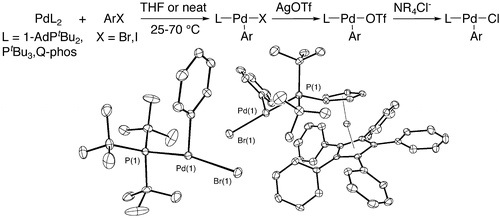Synthesis, Structure, Theoretical Studies, and Ligand Exchange Reactions of Monomeric, T-Shaped Arylpalladium(II) Halide Complexes with an Additional, Weak Agostic Interaction
J. Am. Chem. Soc., 2004, 126 (1184-1194)
View on publisher site
Abstract
A series of monomeric arylpalladium(II) complexes LPd(Ph)X (L = 1-AdPtBu2, PtBu3, or Ph5FcPtBu2 (Q-phos); X = Br, I, OTf) containing a single phosphine ligand have been prepared. Oxidative addition of aryl bromide or aryl iodide to bis-ligated palladium(0) complexes of bulky, trialkylphosphines or to Pd(dba)2 (dba = dibenzylidene acetone) in the presence of 1 equiv of phosphine produced the corresponding arylpalladium(II) complexes in good yields. In contrast, oxidative addition of phenyl chloride to the bis-ligated palladium(0) complexes did not produce arylpalladium(II) complexes. The oxidative addition of phenyl triflate to PdL2 (L = 1-AdPtBu2, PtBu3, or Q-phos) also did not form arylpalladium(II) complexes. The reaction of silver triflate with (1-AdPtBu2)Pd(Ph)Br furnished the corresponding arylpalladium(II) triflate in good yield. The oxidative addition of phenyl bromide and iodide to Pd(Q-phos)2 was faster than oxidative addition to Pd(1-AdPtBu2)2 or Pd(PtBu3)2. Several of the arylpalladium complexes were characterized by X-ray diffraction. All of the arylpalladium(II) complexes are T-shaped monomers. The phenyl ligand, which has the largest trans influence, is located trans to the open coordination site. The complexes appear to be stabilized by a weak agostic interaction of the metal with a ligand C−H bond positioned at the fourth-coordination site of the palladium center. The strength of the Pd···H bond, as assessed by tools of density functional theory, depended upon the donating properties of the ancillary ligands on palladium.
Read on publisher's site